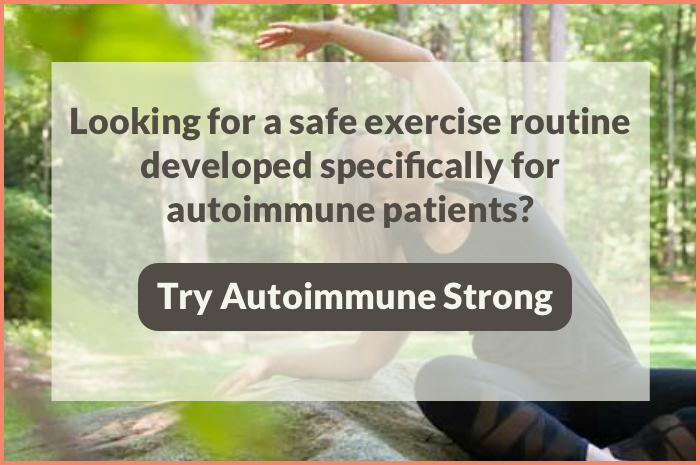 To exercise or not to exercise when you have an autoimmune disease is a dilemma that can’t be resolved with a simple, one-size-fits-all answer. Like many aspects relating to the Paleo Autoimmune Protocol diet and lifestyle, you will need to experiment a little and find what works best for you. And I would go even further, what works best for you today might not be what will work best for you in six months or one year.
To exercise or not to exercise when you have an autoimmune disease is a dilemma that can’t be resolved with a simple, one-size-fits-all answer. Like many aspects relating to the Paleo Autoimmune Protocol diet and lifestyle, you will need to experiment a little and find what works best for you. And I would go even further, what works best for you today might not be what will work best for you in six months or one year.
A while back, I wrote a blog post giving you 9 tips for exercising safely with an autoimmune disease. While these tips are very much still on point, today I wish to share with you my personal experience and how I got back to exercising with an autoimmune disease.
1 – The pros and cons of exercise:
It is common knowledge that exercise is beneficial for our health. Exercise boosts the immune system, improves your mood, and helps you sleep better. Keeping up your workout routine when suffering from an autoimmune disease is a vital part of your self-care and healing process. The long-term benefits of exercising far outweigh the temporary discomfort of a regular and moderate exercise routine. Do whatever you can to keep moving, even if you are tired and don’t feel like doing anything.
Exercise is very therapeutic
in most cases of autoimmune conditions
when done gently and gradually
The only limits to exercising with an autoimmune disease will depend on your abilities at any given time. For example, if you are suffering from joint pain, choose low-impact activities. If you are having a bad day and feel too tired to exercise, take a break and let your body recover.
There is no deadline on your healing journey:
go at your own pace and learn to recognize your limits.
Be aware that too strenuous exercise can trigger autoimmune flares. You will know pretty quickly if you overdo it. Here is a list of signs to monitor:
- you have a hard time recovering after a workout
- you feel unusually tired throughout the day
- you feel like fainting during or after exercise
- you suffer from persistent joint and muscle aches
- you have trouble sleeping at night
- you feel “wired-up” and weak at the same time
If you experience any of these symptoms, back off immediately and rest until your body has had a chance to recover fully. If you miss several days or weeks because of a flare, don’t beat yourself up about it. Just wait for the symptoms to subside and get back to your exercise routine as soon as you are feeling better.
2 – How I got back into exercise:
I received my autoimmune disease diagnosis in 2009 (Hashimoto’s Thyroiditis), and for the first few months, I was in a very bad place. I was suffering from severe anxiety and panic attacks on a daily basis (you can read about my experience here and here), as well as a string of other symptoms like a painful and swollen thyroid, brain fog, insomnia, joint, and muscle pain. I was no longer able to function as a “normal” person. During that time, all I could do at best was to move about the house trying to accomplish a few chores, and prepare meals.
After a few months on the Paleo Autoimmune Protocol, my intense fatigue improved and I slowly regained some energy and vitality. That is when I tried to follow my doctor’s advice to exercise.
I clearly remember my first attempt. I was still weak, but somehow I thought that if I could push through and pretend I had a normal life that things would get better. So I went out and started running in the little neighborhood park. Very. Bad. Idea. I didn’t last even five minutes. Came back home and totally crashed. It took me several days to recover from that. After that first brush with exercise, I understood that I would have to start slow and put my ego on the back burner. I began going on daily walks with my husband around the block. Slowly, we went further and further, and my strength came back progressively.
Start slow and build up your stamina progressively
After walking, I started to attend yoga classes. It is a gentle form of exercise and also a great way to practice some relaxation. I remember barely making it through my first class. My muscles were weak and trembling by the time I rolled up my mat. But I was also so happy to be able to get out of the house, mix with other people and have a social life! Suffering from an autoimmune disease is traumatic and very isolating. Any connection you can make with friends and family will go a long way to lift your mood and bring back some normalcy into your life.
Gentle exercise brings back a sense of
normalcy into your life
After yoga, I ventured into activities a little bit more strenuous, but still gentle on the joints. I was going to the swimming pool to do laps and riding my bike. Such low impact workouts will get your heart rate up while being safe for painful joints. I even tried low impact, high-intensity workouts to get the blood pumping.
Recently, after almost four years on the Paleo Autoimmune Protocol, I was finally able to really up my game and start exercising regularly with a personal trainer. My current routine consists of interval training, steady state cardio, resistance training, core training, and stretches. Read about what happened it in this post!
If you enjoyed this post and are looking for more information on exercise with an autoimmune disease, read these as well:







Yes! Yoga 7 days a week. Perfect for me.
Hello Kelli,
Yoga is fantastic! To be able to practice 7 days a week is awesome 🙂
very encouraging .Thank you.
Hello Tanuja,
Thanks for your positive feedback! Good luck 🙂
Reassuring article…I’m only able to walk slowly around the perimeter of the retirement residence where we live…but that’s an improvement!
In the early days…definitely not. That does not mean lie in bed or be a couch potato. I think movement is very important. For me, the best thing to start was to set an alarm for every 20 mins and get up, go and put the kettle on, or go to the bathroom or just walk to the other end of the house. in the beginning even that was exhausting. But my habit prior to that was go all out for a day, then spend 3-4 days recovering with very little movement. The trick was to learn NOT to go all out even if I felt good on one day. That way I was able to build up stamina slowly. I am not quite a year into the AI protocol and not yet ready for ‘classes’. But I live in a 2 storey house and have a steep driveway so I make sure I have been up and down the stairs at least twice a day, up and down the driveway at least twice a day, as well as go for a 20 to 30 min walk at least 3 times a week. Most of those things are done when doing chores so are not just exercise activities. But I will continue to build up as I can. Another important thing for me was to have confidence in my plan and a ready answer to “well meaning” comments from friends or professionals about exercise. IN the past I had felt ‘guilted’ into exercising and ended up with flareups that just made me miserable and kept sending me back 2-3 steps at a time. Now that I have a plan, I stick to it. It’s flexible enough that I can judge when to up the ante or when to back off a bit – but it is my plan and it works for me, so I no longer feel that I even have to listen to any criticism of it.
Thank you Melanie for your feedback! I so agree with you on “building your stamina slowly”. A very interesting point you are bringing up is that you felt “guilted” into exercising and ended up with flareups. That is so true that you have to listen to YOUR body, learn YOUR limits and pace yourself! Thanks!
Thank you for this encouragement. It gets a little discouraging to feel so tired after doing everyday things. Walking and yoga and stretching-type exercises are all I can handle. I’ve tried some of Katy Bowman’s “Nutritious Movement” exercises (incorporating exercise through everyday movement), and feel like they are helpful.
When you have several Autoimmune diseases as well as heart problems, it can be difficult to have the energy for much exercising. It totally depends on the person and their abilities or lack of.
Hello Bettie,
Thank you for your feedback! I totally agree with you; the level of movement and exercise varies from person to person. There isn’t a one-size-fits-all answer. Just going on walks outside, in nature, is a great place to start!
I absolutely have to exercise right now. If I skip more than a couple days, I start to fade. I’ve worked up to run walking and modified crossfit workouts. I get 4-5 per week and it help immensely. During a bad flare though, just a walk is difficult for me. I feel better getting fresh air though. It’s all based on right now.
Yes. I take PiYo, barre and yoga classes every day that I have the strength and energy. It is very depressing for me when I am too sick to make it to my classes.
Exercise, definitely yes! As long as the person feels up to it. I think its just a matter of listening to your body and doing what you feel is right! Before I was diagnosed I sprinted and lifted weights 6 days a week. Once I found out about the war going on inside my body, I take more days off when I feel they’re needed. There are so many different ways to get exercise! I am a firm believer in “a body in motion stays in motion” and daily (or near daily) movement is necessary to stay healthy!
I do few stretches and a couple of yoga positions. But when i try to increase, I crash for 2 or 3 days after. Sometimes, a couple of abs increased is all what it takes to make me crash.
I thought I’d chime in. I was diagnosed with Scleroderma a year ago. I had just run a marathon and it was a huge shock! It’s been difficult to read people’s experiences with this disease, searching for running and scleroderma only comes up with how people can barely do anything and if they do have immense pain. I generally use running as my “me time” since I have 3 young kids. It keeps me sane and gives me time to socialize with my running-mom friends. My doctor and naturopath have urged me to back off some, but to keep it up if I feel good. I have kept running 25-30 miles per week and try to do some weights or barre or yoga also. I have been feeling good but I have noticed there are days I just need to take off and rest, and I need to drink a ton of water! I have been on an anti-inflammatory diet which has helped with my aches and pains I used to get from running. Just wanted to put my experiences on here, since everyone’s are different. Hopefully I’ll be able to keep on at this pace, but you never know! Good luck to everyone!
Timely article! I was telling a friend today that I feel that I am now at a point I can start some gentle exercises. I’ve had extreme muscle pain in my back/neck due to my Hasimoto’s for almost 2 years. My awesome doctor suggested the autoimmue protocol and after several months of AIP I am almost completely pain free! My doc suggested no strenuous exercise involving my muscles until the inflammation and pain subsided. I’m thinking about starting with some light weights a couple days a week to slowly build up my muscle strength and some yoga. My energy is so much better too so I’m actually looking forward to exercising now.
So wonderful to read your testimonial! Good luck with getting back into exercising 🙂
I have always done these really hard workouts and pushed myself to the limit of almost blacking out several times. One time my pt had to save me from getting the barbell in my head as my face went totally white and I just lost control of my body and just blacked out. She was a bit shaky after that episode and said that the barbell was probably not for me. I never understood why my body was reacting that way. Thanks S!!
Thank you for validating what I’m going through! I have been in “crash” mode and haven’t been able to crawl out of it. I’m going to reset myself and gradually try to get moving a little at a time. It’s so encouraging to see someone else came out the other side and is doing so well!